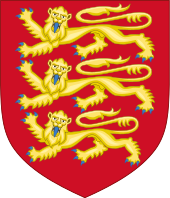Simon Langham
Simon de Langham (1310 – 22 July 1376) was an English clergyman who was Archbishop of Canterbury and a cardinal.
His Eminence Simon Langham | |
|---|---|
| Cardinal, Archbishop of Canterbury Primate of All England | |
| Appointed | 24 July 1366 |
| Installed | unknown |
| Term ended | 28 November 1368 |
| Predecessor | William Edington |
| Successor | William Whittlesey |
| Other posts | Bishop of Ely |
| Orders | |
| Consecration | 20 March 1362 |
| Personal details | |
| Born | 1310 |
| Died | 22 July 1376 |
| Buried | Westminster Abbey |
Life
Langham was born at Langham in Rutland. The manor of Langham was a property of Westminster Abbey, and he had become a monk in the Benedictine Abbey of St Peter at Westminster by 1346, and later prior and then abbot of this house.[1]
Treasurer of England
In November 1360, Langham was made Treasurer of England[2] and on 10 January 1362 he became Bishop of Ely and was consecrated on 20 March 1362.[3] During his time as Bishop of Ely he was a major benefactor of Peterhouse, Cambridge, giving them the rectory of Cherry Hinton.[4] He resigned the Treasurership before 20 February 1363,[2] and was appointed Chancellor of England on 21 February 1363.[5]
Archbishop of Canterbury
He was chosen Archbishop of Canterbury on 24 July 1366.[6]
Perhaps the most interesting incident in Langham's primacy was when he drove the secular clergy from their college of Canterbury Hall, Oxford, and filled their places with monks. The expelled head of the seculars was a certain John de Wiclif, who has been identified with the great reformer Wycliffe.
Notwithstanding the part Langham as Chancellor had taken in the anti-papal measures of 1365 and 1366, he was made cardinal of San Sisto Vecchio by Pope Urban V in 1368. This step lost him the favour of Edward III; two months later, he resigned his archbishopric and went to Avignon.[6] He had already resigned the chancellorship on 18 July 1367.[5] He was soon allowed to hold other although less exalted positions in England.
Death
In 1374, he was elected Archbishop of Canterbury for the second time, but he withdrew his claim and died at Avignon on 22 July 1376.
Langham left the residue of his large estate and his library to Westminster Abbey, and has been called its second founder. His bequest paid for the building of the western section of the nave. Langham's tomb, the work of Henry Yevele, is the oldest monument to an ecclesiastic in the Abbey.
Citations
- Fryde, et al. Handbook of British Chronology p. 105
- Fryde, et al. Handbook of British Chronology p. 104
- Fryde, et al. Handbook of British Chronology p. 244
- "Lyson's Magna Britanica Vol II" The Monthly Review January–April 1812 p. 21
- Fryde, et al. Handbook of British Chronology p. 86
- Fryde, et al. Handbook of British Chronology p. 233
References

- Fryde, E. B.; Greenway, D. E.; Porter, S.; Roy, I. (1996). Handbook of British Chronology (Third revised ed.). Cambridge: Cambridge University Press. ISBN 0-521-56350-X.
| Wikisource has original text related to this article: |
| Political offices | ||
|---|---|---|
| Preceded by John Sheppey |
Lord High Treasurer 1360–1363 |
Succeeded by John Barnet |
| Preceded by William Edington |
Lord Chancellor 1363–1367 |
Succeeded by William of Wykeham |
| Catholic Church titles | ||
| Preceded by Thomas de Lisle |
Bishop of Ely 1362–1366 |
Succeeded by John Barnet |
| Preceded by William Edington |
Archbishop of Canterbury 1366–1368 |
Succeeded by William Whittlesey |
